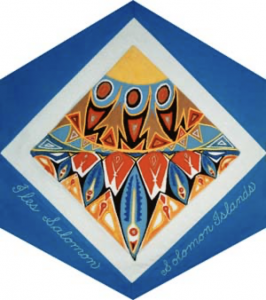Solomon Islands

The Block
The Solomon Islands block is based on an original painting by artist Ake Lianga and features an abstract interpretation of life in his South Pacific archipelago. Quilt-maker Marilyn Vance has beautifully reproduced the balanced lines and curves of the painting in flowing cotton appliqué work and colourful embroidery. Three figures represent the indigenous population, which is made up largely of Melanesians with smaller groups of Polynesians and Micronesians. The fish are the ocean’s sustaining harvest, while birds are important to fishermen lost at sea; their presence out on the ocean carries the promise of land nearby. Tropical sunshine and blue sky blend with the dazzling white of cowry shells, which were once used as currency.
Cultural Profile
The Solomon Islands, known as the “Pearl of the Pacific,” form an archipelago about 1,900 kilometres northeast of Australia. The nation consists of six major islands: Choiseul, New Georgia, Santa Isabel, Guadalcanal, Malaita, and Makira. They are mainly volcanic in origin, while the archipelago also includes more than 900 smaller atolls, islands and raised coral reefs. The geographically active region experiences frequent tremors and its mountainous landscape is largely covered in tropical rainforests. There is an abundance of plant species, including at least 230 varieties of orchids, and hosts of butterflies, some of which have ten-inch wingspans.
Solomon Islanders are a blend of many diverse cultures, languages and customs. Melanesians are the largest ethnic group, comprising 93% of the population, and Polynesians, Micronesians, Europeans and Chinese make up the remainder. Interestingly enough, many Islanders have blond hair and dark skin, a genetic trait which is specific to the Solomon Islands. English is the official language, although it is spoken by very few inhabitants. Pijin English is more widely used, as are the 70 local languages heard throughout the region.
Solomon Islanders believe strongly in maintaining and nurturing communal, familial and clan ties. Most people consider themselves to be part of an immediate family of up to 200 and can trace their ancestry back at least ten generations. Kastom (a Pijin term derived from the word ‘custom’) is the term used to describe any of the many taboos that act as a moral code or guideline for behaviour within village life and the community. For example, the canoe houses were places of worship reserved to men, and featured sculpted timber structures and caskets of important men.
It’s no surprise that tourism is an important service industry on the islands––the stunning array of sea-life makes the Solomon Islands a popular destination for avid snorkelers and scuba-divers––. However, the majority of Solomon Islanders depend on fishing, forestry and subsistence agriculture for much of their livelihood. Copra, the dried, white coconut flesh from which coconut oil is extracted, and trochus shells, used to make buttons and ornamental objects, are two of the islands’ most widely produced items. The Solomon Islands are also known for their unique carvings. Traditional bowls and dishes are crafted from softwood dyed black and inlaid with white shells to create a contrast of colours. Items made for daily use often feature images of life on the islands.
Solomon Islanders have a long history of expert boat building. Their tepukei, outrigger canoes, and their tomoko war canoes can sustain long sea journeys, with the navigators relying on the stars to guide them. These sea traditions still endure today. Figures of warriors used to be carved to show their appearance. It was thought that a beautiful warrior was a more effective one, thus leading the men to pursue physical beauty along with deadly fighting skills. Other carved figurines reveal past religious customs and tell the story of the people’s relationships with the gods.
People have been coming to Canada from the Solomon Islands since 1974, although there are still less than 50 who have become permanent residents.
Sponsor: Caitlyn Bowser & Meredith Royds
